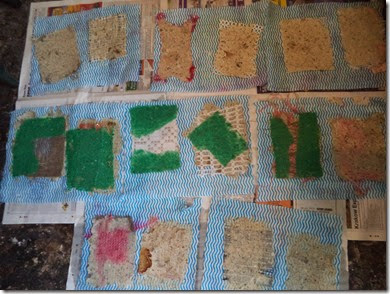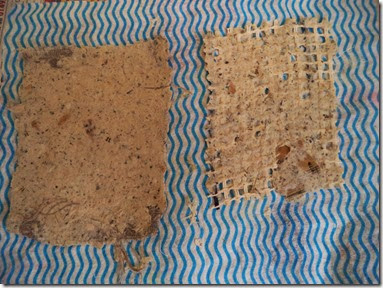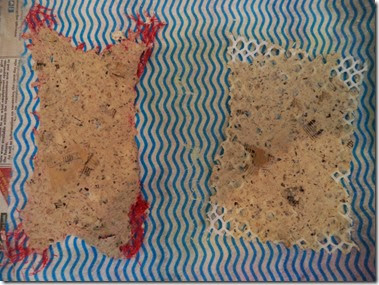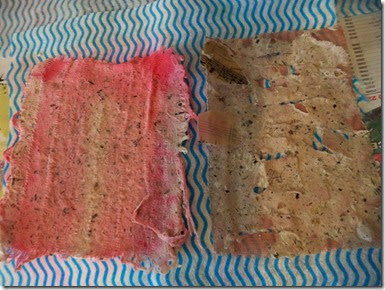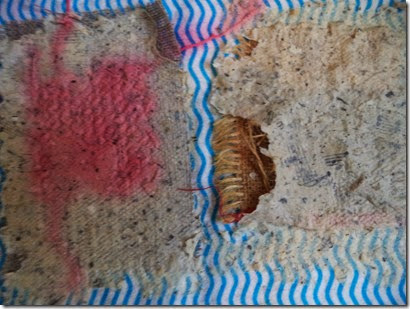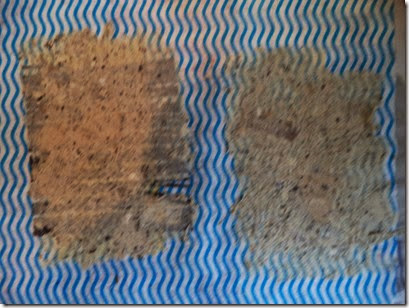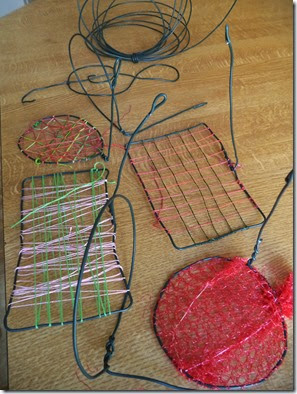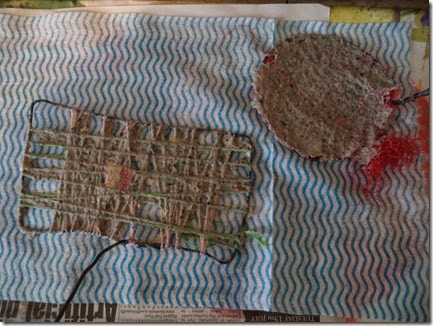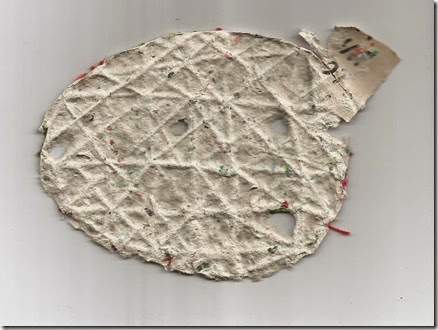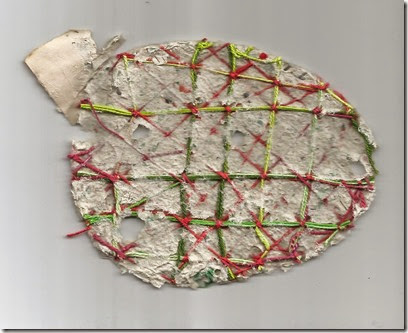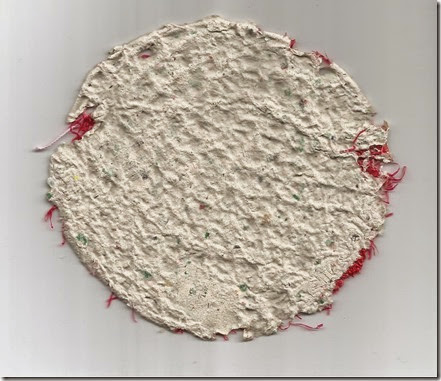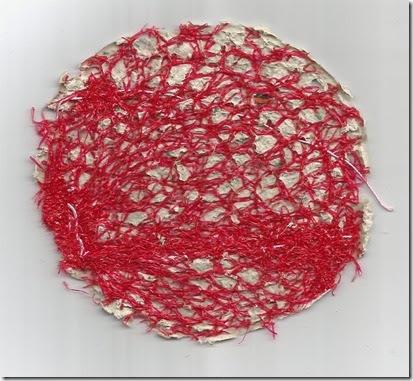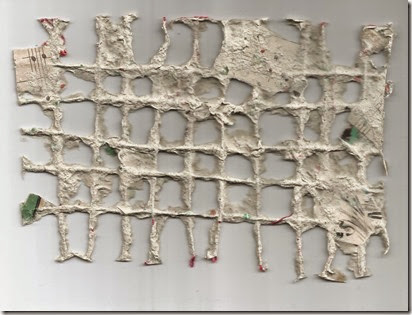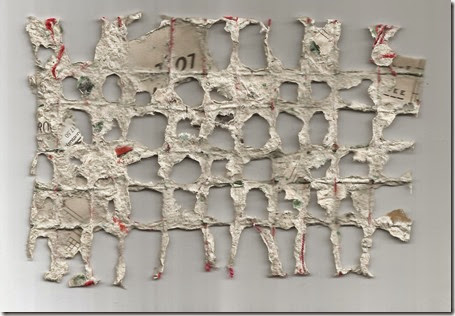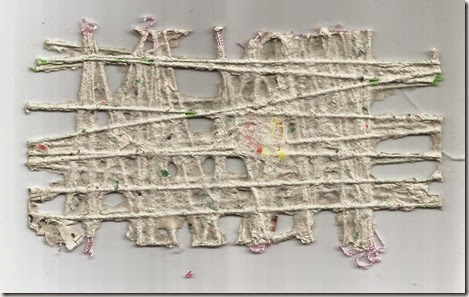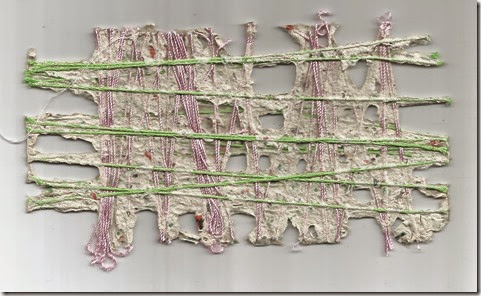Monday 25 August 2014
Chapter 8 Stitching into paper
The inspiration for each sample aims to echo the research theme of lettering patterns, Wales and music, including script and letter designs from Chapter 2. Much of the paper has bits of music in it to add to the effect.
An appropriate background fabric is also selected on to which the paper is attached, which helps prevent weakening of the paper from needle perforations.
There are 11 samples with brief explanations of sources and fabric used. More detailed notes are provided in my notebook. Each sample uses a piece of paper approximately 15cm x 12cm with a background fabric slightly larger, except sample 10 - 11cm x 9cm on fabric 27cm x 13cm.
Sample 1
Use paper fabric sample 1(5),script sample 42k and fabrics: pink dyed fine linen background overlaid with pink chiffon.
The stitches reflect the shapes and colours of 42k, in pink and white rather than dark ink and white, capturing the texture and shading, with an interesting effect on the reverse.
Insert sample 42k, front and reverse of finished piece
Sample 2
Use paper fabric sample 3(6),script sample 42z and fabrics: natural cotton background overlaid with pink chiffon.
The stitches reflect the shapes and colours of 42z, machine stitches and trapped threads the direction of the wash, the hand stitches colour and shapes from the lettering originally from rubbings of PVA wording. This is an abstract piece which reflects the original design.
Insert sample 42z, front of finished piece
Sample 3
Use paper fabric sample 1(4),script sample 42f and background fabric; red polyester.
The paper fabric sample using hexagonal net reflects the shape of the design.
The stitches reflect the shapes and colours of 42f, hand stitching the direction of the script, the different shades of red the changing tone and strength of lettering. This reflects the original design, the waves of pattern, diagonally, horizontally and vertically. Don’t think I’d do this any differently. It is time consuming and it is important to get the spacing of the lines correct. The reverse of the piece shows where running stitch occurs to helped in weaving of threads. The finished piece of paper is soft possibly due to the amount of stitching running through it
Insert sample 42f, front and reverse of finished piece
Sample 4
Use paper fabric sample 1(2),script sample from page 38, Chapter 2 and background fabric; linen canvas to counter the rug canvas in the paper
The paper fabric sample using rug canvas helps in placing spikes of long stitch within holes.
The stitches reflect the shapes of the script sample, colour of thread in red and green for the Wales theme, hand stitching predominates, three shades of green for the lettering, red spikes around the edge and between letters to fill in spaces. I started with green beading wire to give strength to the spikey nature of the script, but it did not show up very well. Would consider using wire for lettering in other work, perhaps varying the thickness of wire. However at least the wire kept the fabric and paper structure other wires might distort.
Insert sample page 38 (2nd line), front and reverse of finished piece
Sample 5
Use paper fabric sample 3(5),script sample 42q and background fabric; bought dyed nylon felt.
The paper fabric sample using embedded scrim provided a flattish surface with some texture for copying the shape of the lettering.
Wanted to produce a leathery or metallic effect on this sample. The stitches reflect the shapes in 42q, hand stitching using satin stitch in the direction of the script. It didn’t matter what colour thread was used as long as it gave some texture. To obtain the finish, coated it with gesso, used walnut ink to stain the dry gesso, adding some burnt sienna acrylic paint to cover any remaining white gesso, once the ink was dry. ( see techniques in Lynda Monk and Carol McPhee’s book ‘Stitching the textured surface’ pp26-30). Copper Treasure gold was rubbed over the lettering, then, as this did not look effective enough continued over the whole of the piece. It was then left overnight to set. This reflects the original lettering design. Trial and error is needed to get different effects, but quite pleased with this first attempt. This technique could be used on music bag planned for final project.
Insert sample 42q, front of piece with stitch only and finished piece (which doesn’t show the shine of the original)
Sample 6
Use paper fabric sample from Chapter 4, script sample 42d and background fabric; green Lutradur.
The paper fabric sample made in Chapter 4 using wide net reflects the shape of the design. The net came away from the paper so was able to lay it at an angle to help with direction shown by lettering and to give the impression of gaps in the text design.
The machine stitches reflect the shape of 42d, machine stitching using overlaid zigzag in the direction of the script, showing some variation in size and shape of the lettering using red thread to complement the green background. This reflects the original design and a relatively simple and quick technique.
Insert sample 42d, front of finished piece
Sample 7
Use paper fabric sample 2(1); pulled thread on linen scrim with paper borders, wanting to develop the idea of showing a small motif of music, treble clef and some words and background fabric; natural cotton to match paper.
The paper fabric sample allowed me to use hand stitching to form notes around the pulled thread rows with bundles of withdrawn threads from earlier work, before attaching the paper to the background fabric. Then once the paper was attached to the fabric allowed for a symbol to be drawn then free machine stitched as well as hand stitching words from part of the song with paper alongside.
This seems a relatively simple way of making a motif that can be appliqued to a larger piece of work.
Insert sample
Sample 8
Use paper fabric sample 1(6), script sample from a photo and card of a hymn book with illuminated manuscript (Granada cathedral) and background fabric; green linen canvas
The paper fabric sample was selected because of the ridged effect along withdrawn thread rows.
Wanted a music style piece, machine stitched lines of score between the ridges, then in order to produce an older music score hand stitched square blocks for the music. In order to highlight the ridges rubbed gently over with Treasure Gold, giving a basic illuminated effect.
This does not look abstract, but I like the overall effect, with fringing. I can imagine also using the hand stitching on a withdrawn thread grid. The illustration below does not show the highlighted effect of the writing, but it does catch the light
Insert sample from book Gwyl Goffa Cymru, ‘Dydd Gwyl Dewi Saint’ (1915), scan of card and front of finished piece
Sample 9
Use paper fabric sample from Chapter 4 and background fabric; green Lutradur.
The paper fabric sample made in Chapter 4 has ‘Cerddol’ embossed on to the surface.
Wanted to produce a leathery or metallic effect on this sample, as in Sample 5, with reference to the same book. To obtain the finish, coated it with gesso, used Quink ink to stain the dry gesso. Once the ink was dry, rubbed Treasure Gold over the whole surface to set overnight. Both ‘Cerddol’ and texture of paper was highlighted. Decided to remove excess green Lutradur using a soldering iron (H & S: ensured well ventilated room, glass and equipment safely used ). Piece was completed making an edge of burnt music score.
Was very pleased with the pewter or leathery metallic effect and hope to use it in the music bag, proposed final piece.
Insert sample
Sample 10
Use paper fabric sample 7(1),script sample 42w and fabrics: browny-grey linen background.
The stitches reflect the shapes and colours of 42w, in black, green and red. The oval paper was made into a crotchet with close zigzag machine stitching.
I chose not to work on the paper other than attaching it to the fabric. This could be used as a motif on a book cover or bag, appliqued or worked directly on to the background fabric. The running stitches helped align the script or marks. Could rearrange the lettering or stitch into the paper, or colour the musical note either with ink, acrylic paint or Treasure Gold.
Insert sample 42w, front of finished piece
Sample 11
Use a new paper sample where pulled thread linen scrim grid was set within a paper border and fabrics: green polyester background.
This evolved. I wanted to use the grid for a Hardanger style stitch (see also Sample 3, Chapter 6), needle weaving using a pale red twisted thread. The stitching needs to be done before attaching to a background fabric. It did not reflect any particular lettering design. Working on the linen I found the fabric had warped and it occurred to me I could use this effect by providing a stuffed background using wadding and apiece of dark green velvet, then attaching it to the polyester background fabric using machine stitching using a set programme on the machine.
Love the 3-D effect, which could be used on a card or box lid. A happy mistake!
Insert 2 sample photos
It is amazing the many options that can arise using the techniques in this chapter.
How versatile stitch, paper and fabric can be, worked together. Some will be used in my final piece.
I feel it would also be useful to use the following which is a grid made from an oblong wire frame, wrapped with threads and removing some of those threads on the reverse to add fringing.
Saturday 9 August 2014
Chapter 7 Applying paper pulp to a woven fabric grid
In this chapter pulp is made as in Chapter 4. Two favourite pulps were chosen:
- Recycled old torn music scores
- Recycled old torn covers from music scores
The pulp is then embedded with different fabric grids including some selected from my fabric collection:
Linen scrim; rug canvas; netting from vegetable bags; curtain net or lace; natural cotton; fine copper mesh; hessian ribbon; foil mesh; sacking; plastic woven matting; fine scrim; loose threads
Others: where threads were withdrawn from the fabric; shapes cut from the fabric; or grids made using a couple of different threads or wires on different shaped garden wire frames
Four methods were used to embed the fabric grids, producing samples approximately 10cms x 15cms:
Method 1: Using fabric grid to scoop up pulp
Method 2: Using metal mesh as in Chapter 4 to lay narrow lengths of pulp around the edge of fabric grids
Method 3: Embedding a smaller grid on to the surface of a made piece of paper whilst still wet
Method 4: Using a made wire framed grid to scoop up pulp
Here is a photograph of most samples from Methods 1 to 3 while they are left to dry on newspaper
Method 1: Using fabric grid to scoop up pulp
8 samples were made using this method (see top row of above image)
- Select fabric grids, or prepare grid: withdraw threads, cut holes, and or distort
- Make paper pulp using old music scores and place in vat
- Hold fabric tightly and scoop up pulp, letting excess water drip off (a frame can be used to attach grid for a firmer structure, but not used in these samples)
- Lay all on kitchen (J) cloth. Either allow to dry naturally as is, or before doing so press with kitchen cloth to remove excess moisture (done with all samples)
The fabric grids used in order were: Linen scrim with pulled thread grid; rug canvas; red vegetable net bag; hexagonal net curtain; fabric diamond grid; ?; natural cotton previously dyed with pulled threads; fine metal mesh (could not pull threads) so cut shapes with musical images.
Samples 1.1 and 1.2 Samples 1.3 and 1.4
All embedded successfully, although I recently noticed that over time the linen scrim (sample 1.1) came apart
Like the distorted effect caused by the weight of the pulp on lifting (sample 1.3), and those that had wider spaced grids which produced holes in areas (samples 1.2 and 1.4). I was surprised that the copper mesh embedded. Perhaps the cut slits and small shapes gathered pulp around edges to hold paper in place (sample 1.8) with interesting textured effects where some paper curled upward. Love the ridged effect where pulp fell through withdrawn dyed cotton (sample 1.7). This latter example may be a useful technique when making the final project.
Samples 1.7 and 1.8
Method 2: Using metal mesh as in Chapter 4 to lay narrow lengths of pulp around the edge of fabric grids
4 samples were made using this method (see middle row of the top image)
- Select fabric grids, or prepare grid: withdraw threads, cut holes, and or distort
- Make paper pulp using old music scores and place in vat (using some from Method 1)
- Place grids on kitchen cloths
- Scoop up some pulp using part of the metal mesh as in Chapter 4, and lay around edges of the grids, so some of the grid is left uncovered.
- Press with kitchen cloth to remove excess moisture (done with all samples) or just allow to dry naturally
With most, repeated the process using a mixture of this pulp and a green coloured pulp dyed re-moistened from chapter 4, and is why the images have green on them. This pulp was put on the nearly dry samples, usually on the back of the paper. I chose to vary the positioning of the green pulp sometimes only adding one piece or across corners.
The fabric grids used in order were: Linen scrim with pulled thread grid; two parallel strips of hessian and foil net ribbon; heavy white curtain lace; large grid of cotton curtain netting
Like the idea of a window of grid through which other material can be woven or the way get glimpses of layers below, and contrasting effect of the fabric and paper (Sample 2.1) The least successful was the foil net ribbon, but using a second layer of the green pulp helped trap it (Sample 2.2)
Samples 2.2, 2.3 and 2.4
Method 3: Embedding a smaller grid on to the surface of a made piece of paper whilst still wet
7 samples were made using this method (4 shown on the bottom row of the top image)
- Select fabric grids, or prepare grid: withdraw threads, cut holes, and or distort (smaller samples than previously)
- Make paper pulp using old music scores and place in vat (using some from Method 1)
- Scoop up pulp using the metal mesh as in Chapter 4 placing sheet on kitchen cloth
- Place grids on top of the paper
- Press with kitchen cloth to remove excess moisture
The fabric grids used in order were: Linen scrim with pulled thread grid and stitching over intersections; sacking with withdrawn thread grid; plastic woven matting with withdrawn threads; loose distorted hessian; neutral fine scrim with withdrawn threads; selection of loose threads
Samples 3.1 and 3.2 Samples 3.3 and 3.4
In most samples the paper and fabric were the same size. In sample 3.1 like the embedding and bleeding of colour from the dyed threads. Sample 3.2 only partly embedded perhaps because of the weight of sacking. The others embedded successfully.
Method 4: Using a made wire framed grid to scoop up pulp
4 samples were made using this method
- Several frames are made using garden wire (the shapes represented those found often on a musical score)
- Grids are made wrapping threads around the frames (at least 2 different threads or fine wire on each)
- Make paper pulp using old music score covers and place in vat (this is different recycled paper from previous methods – providing mottled effect)
- Scoop up pulp using the threaded wire frames placing on kitchen cloth
- Press with kitchen cloth to remove excess moisture or leave to dry naturally
- When dry, leave the paper attached to the frame or cut the paper away using paper scissors
I particularly liked this technique using different shapes and ways of wrapping with threads and wire.
Here are the frames with wrapped threads. The circular ones were particularly difficult to wrap and found it useful tightening the grid using knotting at intersections and on the outer frame. The red netting was kept in place by covering the frame with the netting then gathering with running stitch to tighten in place. I used finer beading wire for the first 5 longer lengths wrapping the rest of the grid with a couple of different threads. Threads used were either 6-ply embroidery cotton, perle and some silk thread.
The handle effect allows you to dip into the pulp and easily remove the frame from the vat.
Here are the papers drying:
When dry each of the papers were cut away from the frames
Sample 4.1 Oval - Front and back of paper
Like the textured effect on the front of this paper but also would consider using the back showing the different colours of the threads.
The grid was sufficient to collect a lot of pulp, but also got the occasional hole.
Can imagine using this as part of a bigger image, such as a musical note, with an extension in stitch or wire.
Sample 4.2 Circle - Front and back of paper
Sample 4.3 Rectangle - Front and back of paper
This grid has wire to form the 5 lines of a musical score, with a widely spaced grid and consequently more holes. It could also be manipulated to form a 3-D structure
Sample 4.4 Rectangle - Front and back of paper
This grid with more threads and narrower spaces has picked up more pulp.
I feel these last two samples would be useful additions on to a piece of work. Could add notes or symbols in stitch or wire.
Some of these will be used in Chapter 8.
























